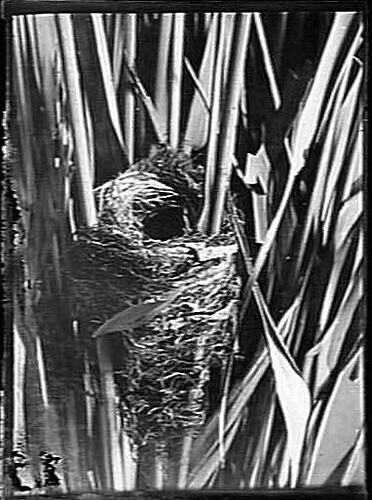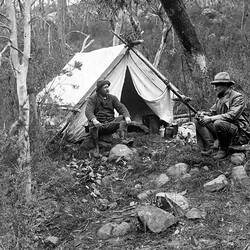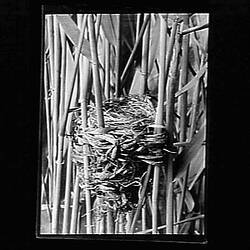REED WARBLER (Acrocephalus Australis, Gould - 246)
Geographical Distribution - Queensland, New South Wales, Victoria, South Australia and Tasmania; also Lombock (A. R. Wallace).
Nest - Cup shaped, deep; outwardly composed of long, soft, pliable stems of aquatic plants, woven and intermixed with swamp débris, roots, &c.; usually firmly secured on four or five reeds standing in water. Other examples are composed of a mass of dark-coloured roots; lined inside in either case with a goodly supply of clean yellowish grass, chiefly the soft tops of flowering portions. Dimension over all, 3 to 3½ inches by 3¼ to 4 inches in depth; egg cavity, 1 5/8 to 1¾ inches across by 2 inches deep.
Eggs - Clutch, three to four; swollen oval in shape; texture of shell close and fine; surface glossy; colour, greyish or greenish-white, faintly spotted, in other instances boldly blotched, with roundish markings of umber or olive of different shades, and grey. Dimensions in inches of a proper clutch: (1) .83 x .61, (2) .82 x .6, (3) .79 x .6; of a smaller sized set: (1) .7 x .54, (2) .7 x .54, (3) .69 x .53. (Plate 9).
Observations - The Reed Warbler is an intensely interesting bird, ranging down Eastern Australia to Victoria and Tasmania, but coming and going mysteriously in the southern parts of its habitat.
Besides being a migrant, the Reed Warbler, as its name indicates, is a merry and cheerful songster, not only by day but by night, its song being quite canary-like. As the bird betakes itself to sedgy sides of rivers and to reeds and rushes of swamps, one cannot always see the birds in such secluded coverts, but their presence or arrival may always be ascertained by hearing their loud merry warbles.
When I first came to Armadale, not far distant from my home there use to be an abandoned brick quarry, partially filled with water, wherein flags grew. Here one or two pairs of Reed Warblers found a secure retreat. Often have I loved to listen to their lively voices, especially at evening, and sometimes through the night.
The following are some promiscuous dates of the arrival of Reed Warblers in the vicinity of Melbourne: -
Season 1886 - Birds heard at Yarraville, 1st September. On the 21st, others heard at Caulfield swamp, where none were present the previous day.
Season 1890 - First birds heard at 'Como' on the Yarra, end of August or beginning of September.
Season 1896 - First heard on the Yarra, near Toorak, 9th September.
Season 1897 - First heard on the Yarra, near Toorak, 9th August.
In the Bendigo district, Dr. W. Macgillivray has noted the Reed Warbler early in August.
My data referring to the Reed Warblers' departure are not so complete. I recollect examining one nest containing young, apparently not many days old, on the 28th January (1895). Nine days afterwards, or on the 6th February, they had flown. February is the month the Warblers commence to retire northward. It was noticed in the neighbourhood of Toorak that during the second week of that month (in 1897) the birds left the river for the shrubs in the gardens close by before finally taking their departure, which was apparently accomplished by the last week of that month.
On a balmy summer day it is a glorious experience for the enthusiastic egg collector, after donning a pair of old pants and boots which will as readily let water out as in, to walk through the sedges of a swamp. He quickly gets lost to view in the tall ranks of thick reeds, which he parts with first one hand and then the other, proceeding slowly, not unfrequently floundering into a hole, and consequently finding himself suddenly up to his arm-pits in the cooling water. Now and again a nest is espied, about two feet above the surface of the water, built on a few upright flags, and containing two, three or four, as the case may be, of the familiar greyish, brown-mottled eggs.
On the margins of the Yarra, near Melbourne, some of the Reed Warblers, on account of the absence of reeds, suspend their nests in the drooping green tresses of willows that hang over thee river. As a rule, the Reed Warbler builds over water, but instances are known where nests have been observed on dry land, perhaps fifty paces from water, in herbage, such as flowering stocks of dock-week, &c.
The first eggs are usually laid about the middle of October. At the height of the breeding season Reed Warblers appear to build their nests very rapidly. On the 24th November (1888) I visited a strip of sedges in a favoured locality and found two or three nests building. Going through the same sedges eleven days subsequently I examined no less than fourteen nests containing a total of thirty-eight eggs, mostly fresh, or an average of 2 4/7 per clutch.
Respecting the Reed Warbler in a more northerly habitat, I possess Mr. Herman Lau's note from South Queensland. He says: - 'Reed Warbler - one of our best singers, in all respects like its European cousin - lays three eggs. Sings during incubation at all times, even during the night. Comes to Queensland in the latter end of August, and leave, after rearing two broods, in February. Took eggs at Tummaville, twelve miles south of Yandilla, 1868.'
The illustration, although conveying a fair idea of the nest, is hardly a successful photograph.
Resources
Transcribed Archibald James Campbell. Nests and Eggs of Australian Birds, including the Geographical Distribution of the Species and Popular Observations Thereon, Pawson & Brailsford, Sheffield, England, 1900. Page 181-183.
More Information
-
Keywords
-
Authors
-
Contributors
-
Article types



